Nano meeting tackles consumer exposures
By Eddy Ball

NIEHS leadership at the meeting included Woychik, right, who welcomed attendees and discussed the role nano research plays in the NIEHS strategic plan, and Collman, who looked forward during her closing remarks. (Photo courtesy of Steve McCaw)
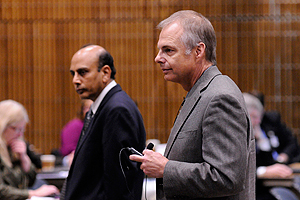
Shortly after he began his keynote address, Wiesner, right, abandoned the podium for more intimate engagement with the audience. He was joined by Nadadur during the question and answer segment. (Photo courtesy of Steve McCaw)

EPA scientist Kevin Dreher, Ph.D., (http://www.hsc.wvu.edu/ccrs/cvtss/PDF's/Dreher%20Bio.pdf) led off the first session with a discussion of “ENMs risk assessment: health effects primer.” In his review of health effects research, he said, “There are many confounding factors. Those things [ENMs] change as they go through the environment.” (Photo courtesy of Steve McCaw)
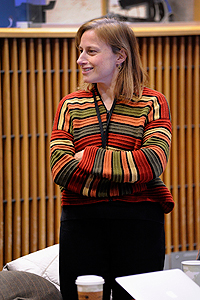
Contrasting the workshop experience with the state of the science that informed her 2006 testimony (http://www.consumersunion.org/pdf/foodtest1006.pdf) before a U.S. Food and Drug Administration panel, Cairns said she felt hopeful about advancing understanding of exposure and risk in the general population. (Photo courtesy of Steve McCaw)
An impressive lineup of speakers at the NIEHS Nano Exposure Workshop Jan. 9-10 underscored how much scientists still don’t understand about the health effects of engineered nanomaterials (ENMs), more than a decade after studies of their toxicology first began to appear in the PubMed-indexed literature.
The latest in a series of initiatives led by NIEHS to advance understanding of nanomaterials (see text box), the workshop was organized by NIEHS program administrator Sri Nadadur, Ph.D., who manages the nano grants portfolio. The goal of the workshop was to initiate a discussion with researchers in the fields of nanomaterial science, toxicology, exposure assessment, consumer protection, and epidemiology, to prioritize the research directions for gaining comprehensive understanding of potential health effects from nano-enabled consumer products. Welcoming remarks by NIEHS Deputy Director Rick Woychik, Ph.D., emphasized the urgent need to understand how these materials may interact and contribute to health effects, as the number of products containing nanomaterials continues to increase at a rapid pace.
“I think [it’s important] having all the parts of the health research spectrum represented here and talking together,” said participant Carolyn Cairns, program leader for product safety at Consumers Union. “Now we’re [specifically] talking about product-related exposure.”
Keynote sets the tone for panel discussions
Addressing “Progress towards predicting environmental exposure to engineered nanomaterials” was one of the field’s leading authorities, environmental engineer Mark Wiesner, Ph.D., (http://wiesner.cee.duke.edu/node/23) director of the Duke University Center for the Environmental Implications of NanoTechnology. Wiesner described advances in nano research that seem to raise as many questions as answers, especially about what happens as the relatively stable products change and break down during the course of their life cycles.
“It’s important to understand the uncertainties,” Wiesner told the audience. In the world of nano-scaled metals and elements, Wiesner explained, structure-related peculiarities explain only part of ENM behavior and potential impact on health. Manufacturing conditions, mixtures, and interactions with the environment, along the course of the material’s life cycle, can alter the material and influence its exposure and risk potential.
Spheres of agreement
The workshop was divided into four sessions, each with a set of major questions to guide panel presentations and discussion — nano environmental health and safety, tools for nano exposure assessment, consumer exposure to ENMs, and knowledge and needs for epidemiology of ENM exposures.
In any gathering of toxicologists, exposure biologists, epidemiologists, and researchers from other disciplines, there are bound to be points of contention, but there was a remarkable level of consensus about several issues. It remains unclear what the exact volume of ENMs is in production, what products contain them, or how ongoing research and development will change their character in the future — something that expanding public-private partnerships may help address.
Initial studies of exposure in occupational settings are only now getting underway, laboratory characterization of nanomaterials is early in development, and epidemiologists struggle with questions about where to begin in the design of the large population studies that are sorely needed to define exposure and forecast risk. Understanding the fate of ENMs, after they enter the body through inhalation, ingestion, and dermal exposure, remains incomplete.
Even the research infrastructure, several speakers observed, is still inadequate. The National Health and Nutrition Examination Survey (NHANES) — a major resource for environmental health studies and public health efforts — doesn’t yet analyze tissue samples for nanomaterials, researchers still struggle with characterization, and the National Library of Medicine is still in the process of expanding its PubMed index and other database coverage of nano research.
Moving forward with partnerships
In her final remarks to the attendees, NIEHS Director of the Division of Extramural Research and Training Gwen Collman, Ph.D., spoke encouragingly of the spirit of cooperation evident throughout the workshop. She pointed to offers to share samples and assessment platforms; proposals for cross-disciplinary teams with specialists in toxicology, exposure assessment, and epidemiology; advancing strong interagency partnerships; and the prospect of novel partnerships with private sector stakeholders.
Several attendees stayed on after the workshop to participate in the NIEHS-hosted Nanomaterials Characterization Workshop organized by ILSI (http://www.ilsi.org/RESEARCHFOUNDATION/Pages/RSIA.aspx) and the University of Michigan Risk Science Center.
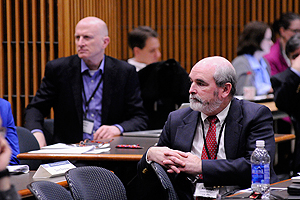
Richard Canady, Ph.D., left, director Center for Risk Science Innovation and Application at ILSI, was one of the co-organizers of the Nanomaterials Characterization Workshop that followed the exposure meeting, while grantee Terry Kavanagh, Ph.D., (http://deohs.washington.edu/research-centers/faculty-directory-and-research-interests/terrance-j-kavanagh) of the University of Washington, was a panelist in the session on nano environmental health and safety. (Photo courtesy of Steve McCaw)
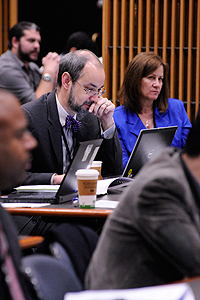
NIEHS program administrator David Balshaw, Ph.D., left, moderated the tools session, which included discussion of some of the personal sensors developed with grants he oversees. National Institute for Occupational Safety and Health project leader Laura Hodson, right, described ongoing industry-wide occupational exposure assessment studies (http://ntp.niehs.nih.gov/ntp/About_NTP/BSC/2011/April/Nanomaterials.pdf) by her group, funded in part by NTP. (Photo courtesy of Steve McCaw)
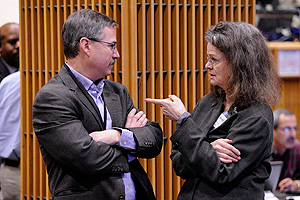
Offering an example of the cross-disciplinary cooperation nurtured by the workshop, grantee Mary Wolff, Ph.D., (http://www.mountsinai.org/profiles/mary-snow-wolff) right, an epidemiologist at Mount Sinai Medical Center, took advantage of a break to talk with environmental biomarker specialist Justin Teeguarden, Ph.D., (http://biomarkers.pnnl.gov/staff/teeguarden.asp) of Pacific Northwest National Laboratory. (Photo courtesy of Steve McCaw)

Although most of the evidence suggests ENMs do little harm as they pass through the gastrointestinal tract, grantee James Bonner, Ph.D., of North Carolina State University noted a possible exception. Because of its antimicrobial properties, silver could impact healthy balance of flora in the microbiome. (Photo courtesy of Steve McCaw)
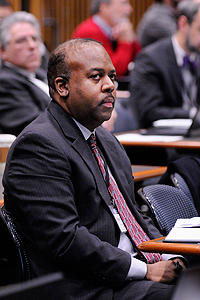
Consumer Product Safety Commission (http://www.nano.gov/node/139) toxicologist Treye Thomas, Ph.D., moderated the consumer product session. He said such products drive exposures among children and other susceptible groups. (Photo courtesy of Steve McCaw)

Grantee Martin Philbert, Ph.D., (http://www.sph.umich.edu/iscr/faculty/profile.cfm?uniqname=philbert) dean of the University of Michigan School of Public Health, left, commented on Wiesner’s description of life-cycle modifications of ENMs. “All these properties change as you go from system to system,” he said. NIEHS program administrator Caroline Dilworth, Ph.D., right, organized and moderated the epidemiology panel. (Photo courtesy of Steve McCaw)

NTP Deputy Director for Science Nigel Walker, Ph.D. , helped to ground the nano environmental health and safety session with his presentation on “Classical risk assessment paradigm.” (Photo courtesy of Steve McCaw)
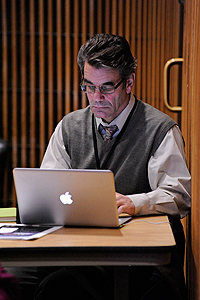
Bethesda-based NIEHS Toxicology Liaison Chris Weis, Ph.D., was on hand for the workshop and represented NIEHS at the Nanomaterials Characterization Workshop that followed. (Photo courtesy of Steve McCaw)
NIEHS gives nano research a big push forward
Along with individual researcher-initiated grants, NIEHS nanotechnology Grand Opportunities (Nano GO) grants gave researchers two years of funding (see story) for grantees to work together toward the common goal of developing methods to achieve greater harmonization of research results for hazard assessment of ENMs. The consortium researchers conducted several collaborative research projects, structured as a series of round-robin tests, in which similar or identical methods were used to perform in vitro and in vivo tests concurrently at thirteen different laboratories around the country.
The NIEHS Centers for Nanotechnology Health Implications Research (NCNHIR) Consortium, formed in 2010, consisted of eight cooperative centers along with several other active grantees funded through the Nanotechnology Environmental Health and Safety program (see story). NIEHS also established contractual agreements with the Nanotechnology Characterization Laboratory for nanomaterial characterization, and with the National Institute of Biomedical Imaging and Bioengineering to create an informational database.
During its two years of funding, NCNHIR supported opportunities for grantees through NIEHS programs, including Nano GO, Challenge Grants, Outstanding New Environmental Scientist (ONES), and research project grants, to share and integrate data. The interactions among nano scientists laid the foundation for the kinds of cooperative efforts and interagency partnerships fostered by the Nano Exposure Workshop.
"Autoimmunity expert delivers distinguished ..." - previous story ![]()
![]() next story - "NIEHS researcher assists in ..."
next story - "NIEHS researcher assists in ..."
February 2013 Cover Page


